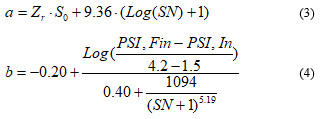The empirical method is proposed by the AASHTO GUIDE FOR DESIGN OF PAVEMENT STRUCTURES. This method is based on considerations derived from experimental tests conducted. The general principle of the method is to measure the adequacy of the road pavement in terms of the number of vehicles (standard axles of 82 kN) that a road pavement can withstand while maintaining the desired functionality for a certain number of years (set as a design parameter and, in most cases, equivalent to the road's service life). The measure of the adequacy of the road pavement is given by the following expression:

Where N8.2,Lim is the number of standard axles (82 kN) that the road can withstand over its useful life, while N8.2,Calc is the number of standard axles (82 kN) that actually transit on the designed road. The calculation of N8.2,Lim is carried out according to the following equation:
![]()
Where:

In equations (2), (3), and (4), the meaning of the various symbols is as follows:
•Zr: is a term related to the reliability R according to which the adequacy verification (or design) is to be conducted;
•S0: is a statistical term that measures the standard deviation accounting for the error made in predicting traffic volumes and pavement performance. S0 assumes values between 0.4 and 0.5. Higher values indicate greater probable errors in estimating traffic volumes and pavement performance;
•SN: is the Structural Number (thickness index) in inches;
•PSI,Fin: is the pavement performance index at the end of its service life (typically ranging from 2 to 2.5);
•PSI,In: is the pavement performance index at the beginning of its service life (typically ranging from 4 to 5);
•Mr is the resilient modulus of the subgrade, expressed in psi (pound per square inch);
Further details on the calculation of the terms that contribute to estimating the adequacy of road pavement using the empirical method can be found in the document THE AASHTO EMPIRICAL METHOD FOR PAVEMENT DESIGN.